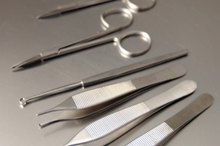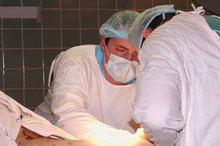List of Surgical Instruments
Surgery is defined by the "Medical Dictionary" as the "branch of medicine that is concerned with ... conditions that are amenable to, or require, operative procedures." During an operation, or surgical procedure, a trained surgeon uses various tools to manipulate the body's tissues and organs 2. While some surgical tools, such as scalpels and suturing needles, are used for most operative procedures, others are more specialized and may be used only within a certain branch of surgery, such as orthopedics or neurosurgery.
Scalpels
A scalpel is a fine-edge cutting instrument with a blade that allows the surgeon to exert maximum control while cutting tissues, and is used to make incisions in the skin or other tissues. Scalpels are available in both disposable and stainless steel varieties, and in a range of sizes. The scalpel is most commonly used to make the initial incision that opens the body for surgery.
Scissors
Types of Surgical Staples Used Internally
Learn More
Scissors are used to cut tissue or other materials during operative procedures, and come in a range of sizes and types. All scissors are classified as either sharp or blunt and straight or curved. Mayo scissors may be used to cut sutures and heavy body tissues, while smaller varieties, such as Metzenbaum scissors, are employed in cutting delicate materials. Blunt scissors are used to cut sutures and dressings.
- Scissors are used to cut tissue or other materials during operative procedures, and come in a range of sizes and types.
- Mayo scissors may be used to cut sutures and heavy body tissues, while smaller varieties, such as Metzenbaum scissors, are employed in cutting delicate materials.
Forceps
Surgeons use forceps during surgical procedures to hold onto or manipulate tissues and to clamp blood vessels. Surgical forceps are hinged instruments, similar in design to scissors, but with tong-like or flat tips that are used to hold, clamp or move tissues during surgery. Forceps come in three varieties: tissue/dressing forceps, intestinal forceps and hemostats (used to clamp blood vessels). Forceps, like scissors, may be classified as curved or straight and may or may not have small "teeth" at the tips.
- Surgeons use forceps during surgical procedures to hold onto or manipulate tissues and to clamp blood vessels.
- Surgical forceps are hinged instruments, similar in design to scissors, but with tong-like or flat tips that are used to hold, clamp or move tissues during surgery.
Retractors
Types of Surgical Needles & Their Uses
Learn More
Surgeons use surgical retractors to pull back, hold open or move tissues during surgery. Two types of retractors are used: self-retaining and hand-held. While self-retaining retractors lock into place, the hand-held variety must be held in place by an assistant during a procedure. The design of retractors reflects their function; surgeons use lung retractors, rib spreaders and skin retractors, among others. The design of retractors is similar to scissors--a hinged instrument, but with prongs or ridges on the ends for grabbing.
- Surgeons use surgical retractors to pull back, hold open or move tissues during surgery.
- The design of retractors reflects their function; surgeons use lung retractors, rib spreaders and skin retractors, among others.
Needle Holders
Needle holders are hinged instruments that have a carbide insert in the tip to prevent slipping. They are used to hold the needle when sewing body tissues, which provides more control than sewing by hand. Needle holders may or may not also have cutting blades that can be used for cutting thread.
Related Articles
References
Resources
Writer Bio
Dayna is a freelance writer, artist and former high school teacher. She has been writing professionally for three years, and hold degrees in physical anthropology, art and special education. Her particular areas of interest include anthropology, health and nutrition, fitness and beauty and skin care.







